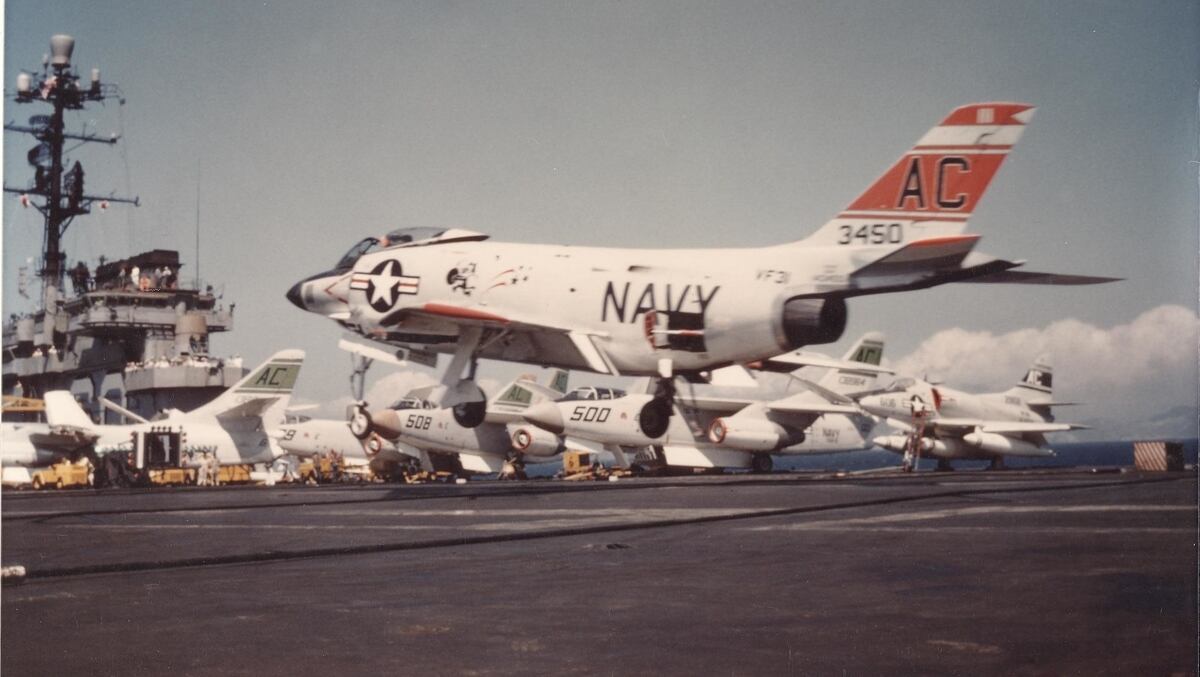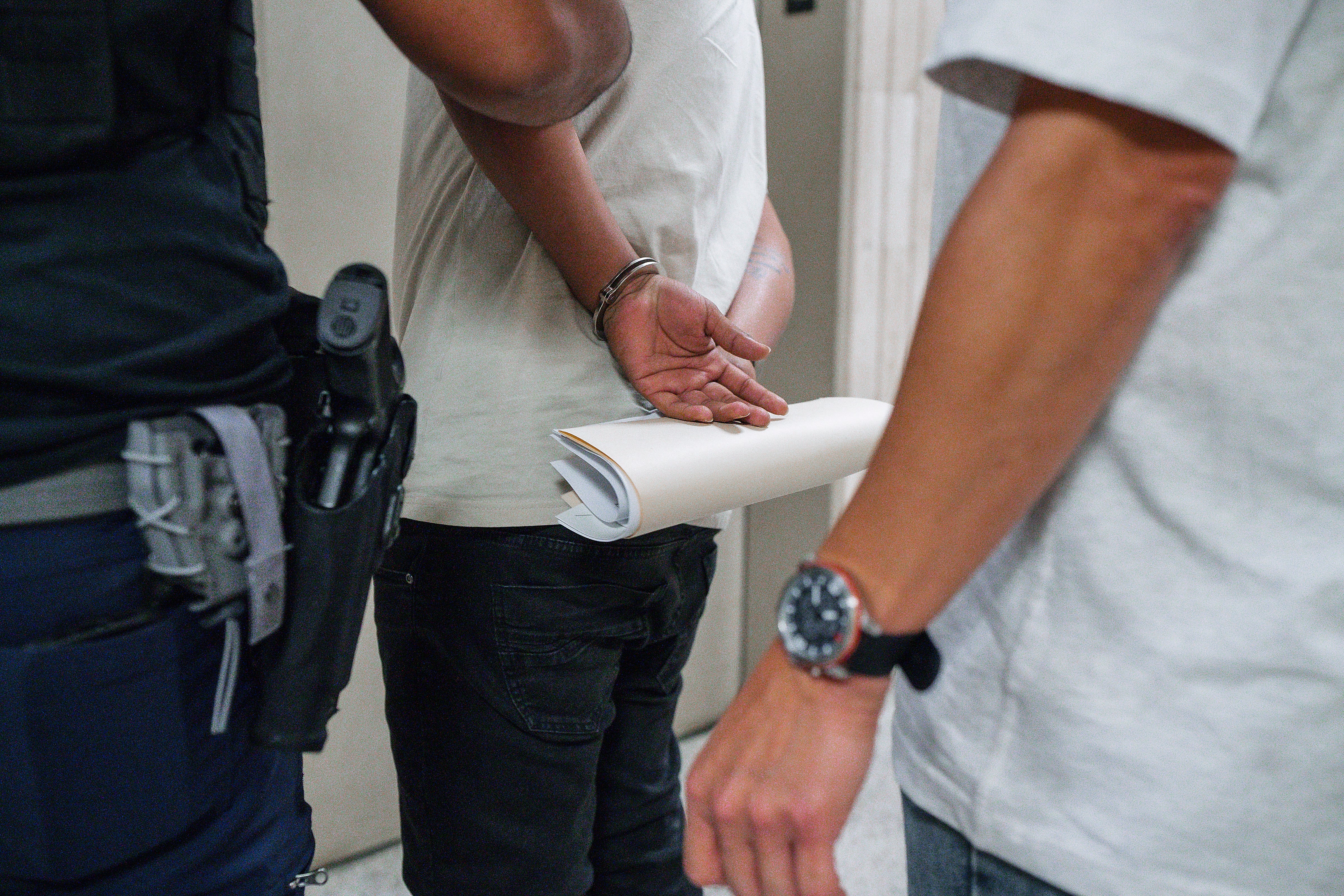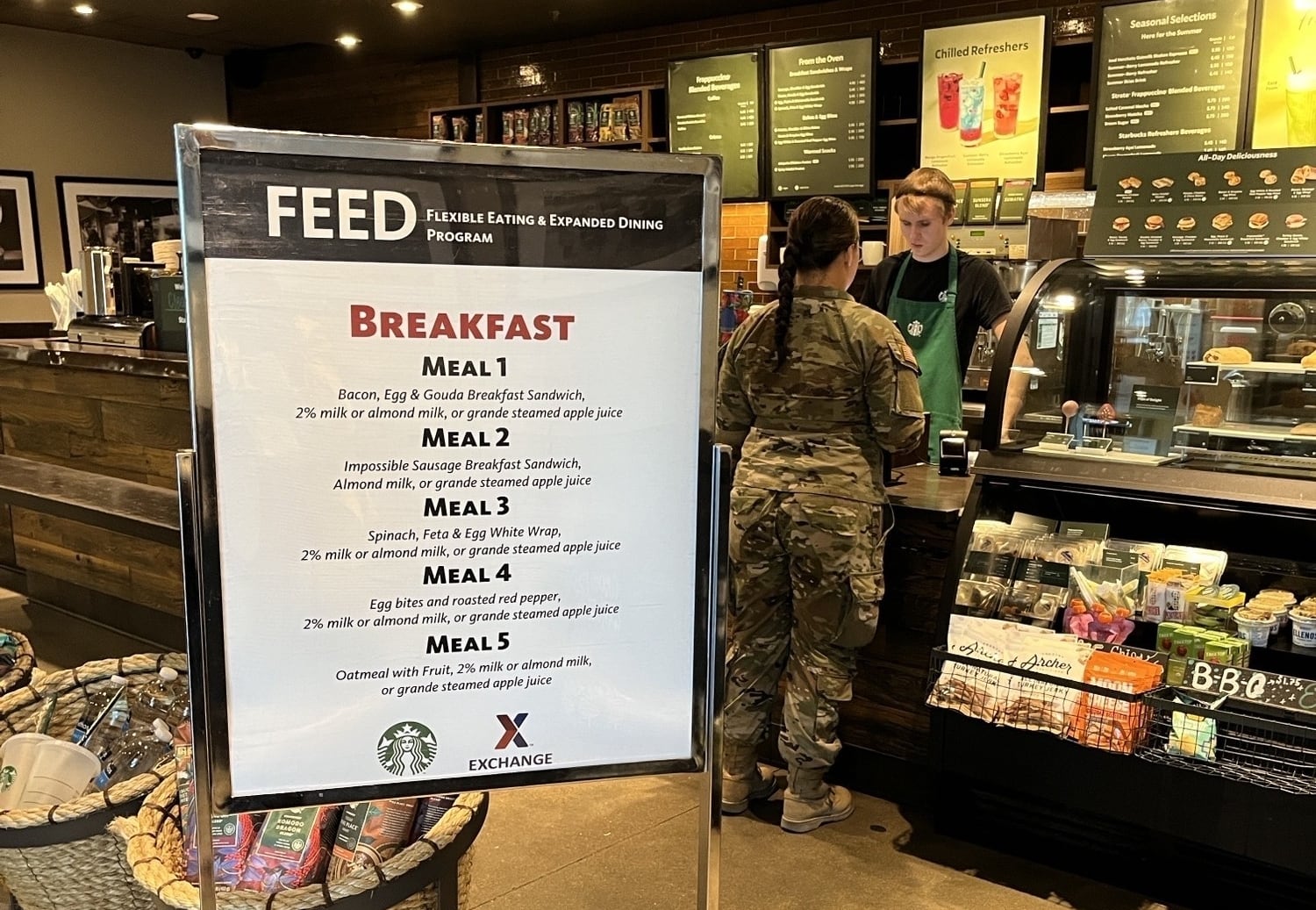Sometimes truth is stranger than fiction, especially in aviation history.
An extraordinary example occurred near Naval Air Station North Island near San Diego during the early 1950s: While performing flight testing from an aircraft carrier, the catapult bridle — a device that connected the airplane to the catapult shuttle — had jammed the nose gear strut of a Chance Vought F7U-3 Cutlass, so that the gear would neither fully retract nor extend.
Repeated efforts by the pilot to shake the bridle loose proved futile. Because attempting to land on the jammed nose strut was deemed unsafe, the pilot of the Cutlass was directed to fly over the base, point the aircraft out to sea and eject.
Minutes later, after a successful ejection and seat separation, a crash crewman riding in a truck watched the pilot make a safe parachute landing in a nearby field.
The crewman jumped out of the truck and ran up to the pilot. Pointing overhead, he exclaimed, “Your buddy’s still up there!”
Giving the man a confused look, the pilot said, “Buddy? I don’t have a buddy up there.”
But looking up, following the man’s finger, he saw it — his Cutlass — descending and turning back toward where the two men stood.
Both were frozen in place as they watched the jet continue to circle and lose altitude. Coming in lower, the unpiloted F7U-3 missed colliding with the central cupola of the famous Del Coronado Hotel by scant feet, then moments later neatly landed on Imperial Beach.
Damage was so slight that the aircraft was later repaired and returned to service.
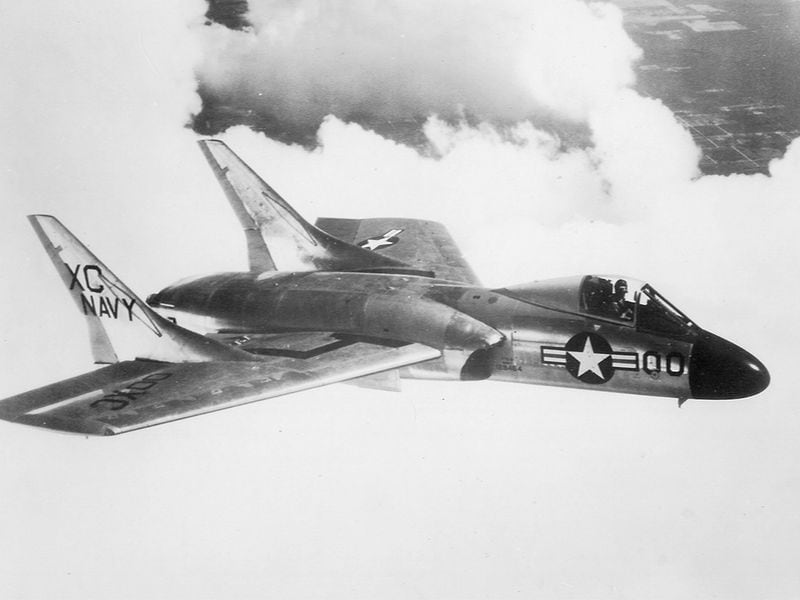
When jet aircraft began making their appearance during World War II, officials at the U.S. Navy’s Bureau of Aeronautics weren’t completely sure they could be safely operated from the deck of an aircraft carrier.
Development trials carried out in 1946-47 with the McDonnell FD/FH-1 Phantom and the North American FJ-1 Fury demonstrated that carrier-based jet operations were practical.
In terms of performance, however, no truly combat-capable jet fighter emerged until Grumman F9F Panthers and McDonnell F2H Banshees began reaching operational units in 1949 and 1950
Even though these new jets were considerably faster than the prop-driven planes they replaced, they still didn’t measure up to swept wing, land-based jets (e.g., the F-86 and MiG-15) entering service at the same time.
The deficit in naval air superiority was never more apparent than during the Korean War, when Navy and Marine Corps aircraft were forced to either avoid airspace within the range of marauding MiGs or rely upon protection from U.S. Air Force F-86s.
The need to close the air superiority gap confronted the Bureau of Aeronautics with highly complex problems.
At a minimum, any new carrier-based fighter needed to be fast enough to engage enemy aircraft traveling at transonic speeds (more than 600 mph at 40,000 feet) and, in due course, supersonic speeds (more than 660 mph at 40,000 feet).
The Navy fighters should be equipped with radar for night and all-weather operations, and had to be capable of operating from carrier decks ranging in length from 820 feet (Essex class) to 900 feet (Midway class).
Modifications that would improve the carrier fleet’s ability to handle higher-performance jets (i.e., angled decks, steam catapults, etc.) were still years away, and the Navy’s hoped-for “super-carrier” program was abruptly canceled in 1949 as a cost-cutting measure. In fact, no carrier built specifically to handle jets would join the fleet until the mid-1950s.
Undeterred, the Bureau of Aeronautics and its partners in industry met this challenge by generating 11 different fighter designs between 1948 and 1958: eight under new type designations (F7U, F4D, F3H, F10F, F11F, F8U, F5D and F4H) and three more as subvariants of existing types (F9F-6, 7 and 8; F2H-3 and 4; and FJ-2, 3, 4 and 4B).
All 11 reached flying prototype status, and remarkably all but two actually achieved operational carrier service, albeit short-lived in some instances.
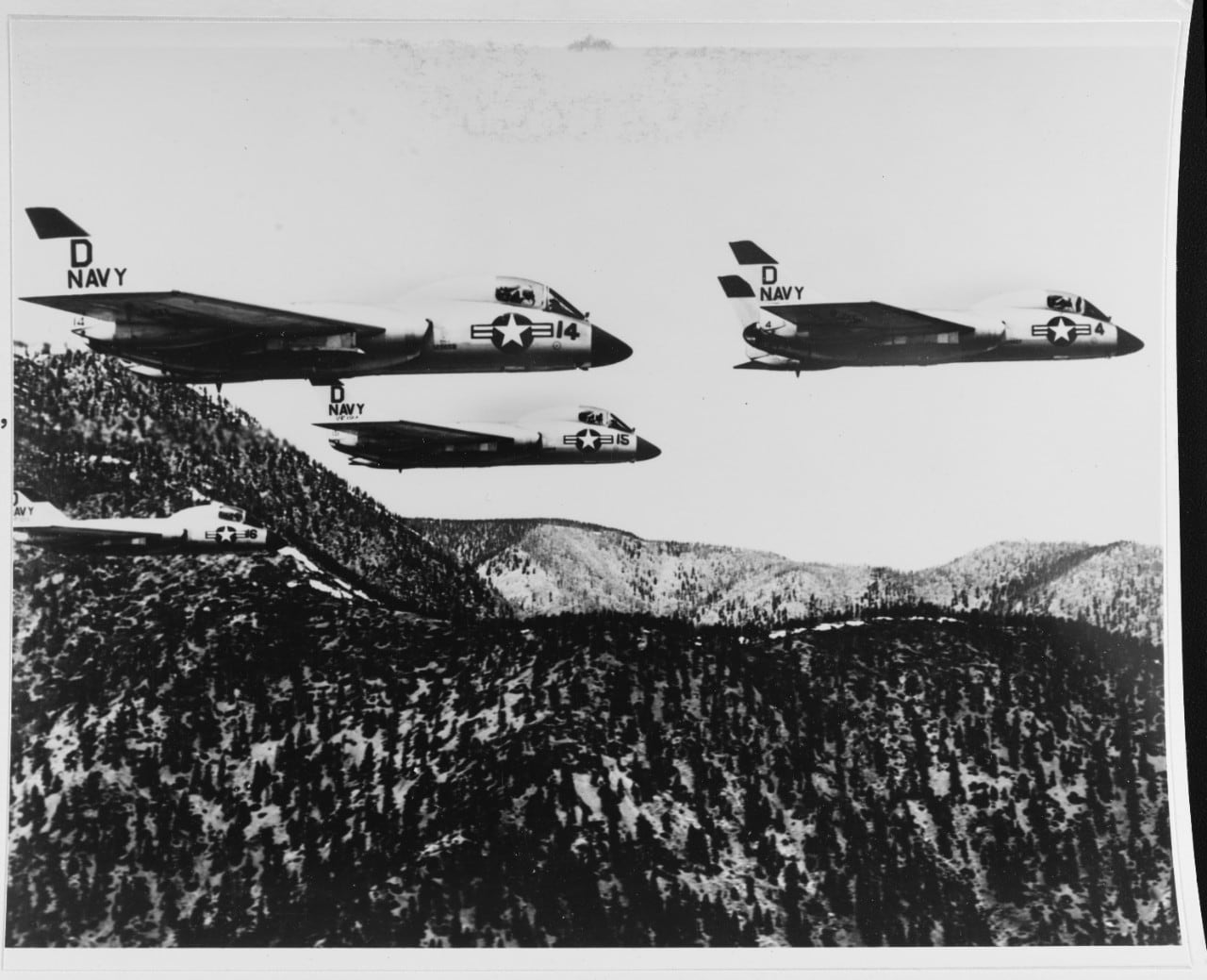
F7U Cutlass
The mass of aeronautical test and research data captured from Germany at the end of World War II had a sweeping impact on military aircraft developments in the United States. Designed to meet a mid-1945 naval requirement for a 600-mph carrier fighter, Chance Vought’s F7U Cutlass owed much of its unique configuration to data on tailless aircraft acquired from the German Arado company. The data suggested that elimination of the horizontal tail would avoid the extreme nose-down forces experienced by conventional airplanes at speeds above Mach 0.75.
The twin-engine XF7U-1, which first flew in September 1948, featured a low-aspect-ratio wing swept to 38 degrees with vertical tail surfaces mounted on the wings at mid-span. Roll and pitch control was combined in “ailevators” (i.e., elevons) located on the trailing edges of the outboard wing panels. For slow flight, during takeoff and approach, the wing included large full-span leading edge slats, but no flaps.
Powered by two Westinghouse J34 engines, the three XF7U-1s were followed by 14 F7U-1 production models. After lengthy trials, the F7U-1 was deemed generally unsuitable for carrier operations due to poor pilot visibility during landing approach (caused by the very high angle of attack needed at low airspeeds), poor wave-off characteristics and arresting hook problems.
The similar F7U-2 was canceled, but the improved F7U-3 flew in December 1951 with more powerful Westinghouse J46 engines and a totally redesigned nose that housed a radar and fire-control system for all-weather operations. Other enhancements included wing pylons for either external fuel tanks or air-to-ground ordnance. Standard air-to-air armament consisted of four 20mm cannons. Beam-riding Sparrow missiles were added in the -3M version.
The Navy ordered 180 F7U-3s, followed by 98 missile-carrying F7U-3Ms, the last delivered in 1955. F7U-3s and -3Ms served with 10 fleet fighter squadrons between 1954 and 1957, some of which were redesignated as attack squadrons.
Though it turned out to be a maneuverable and stable weapons platform, the subsonic Cutlass was plagued by the need for excessive maintenance as well as a high accident rate, and by the mid-1950s it was obsolete compared to newer supersonic designs reaching advanced stages of development.
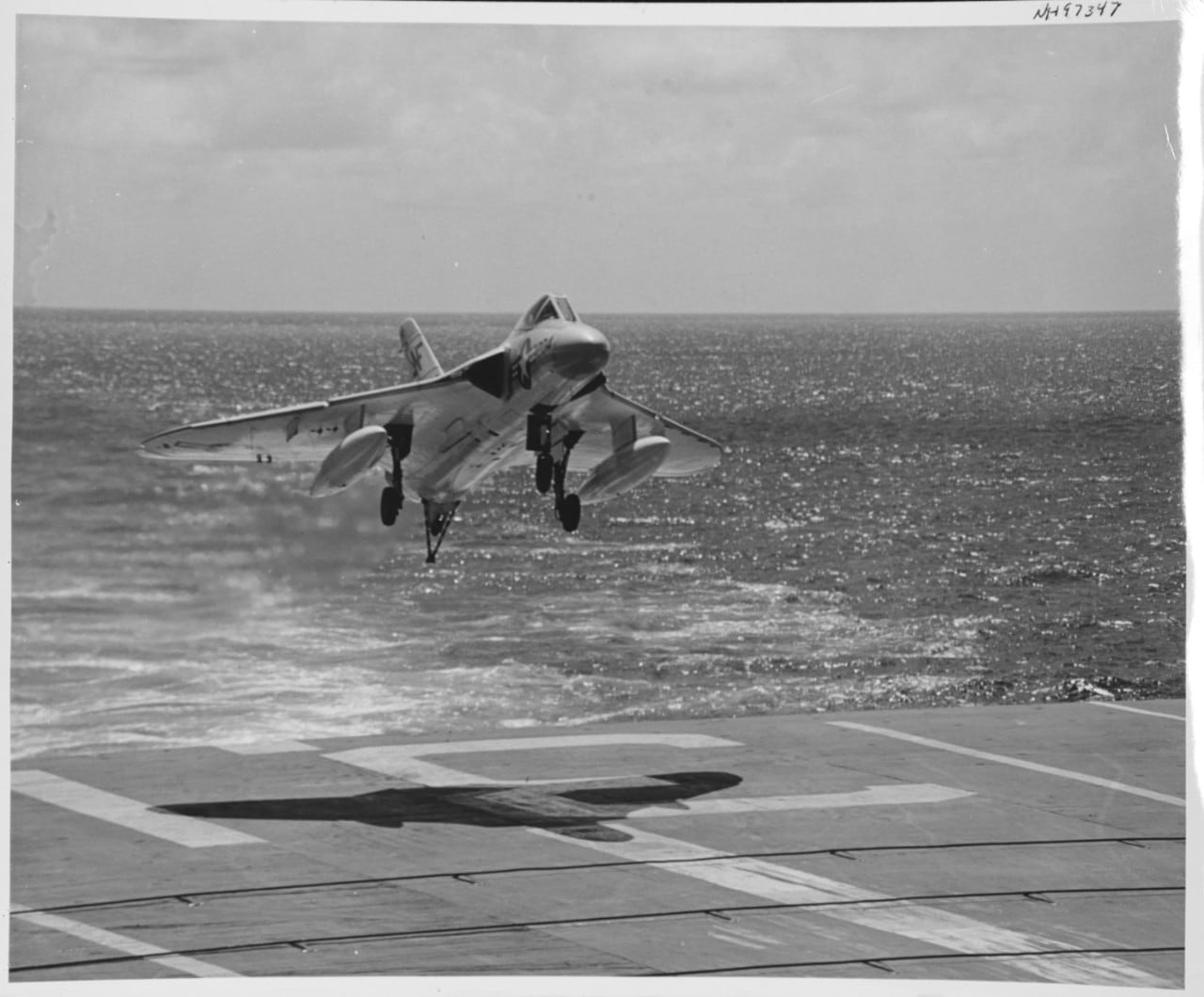
F4D Skyray
Another product of captured German research — Messerschmitt this time — the Douglas F4D Skyray emerged from a 1947 design competition for a delta-wing naval fighter.
The delta configuration was seen as a means to produce a plane optimized for high rate of climb yet fast enough to intercept enemy aircraft before they reached their targets. Early on, however, the Douglas team abandoned the pure delta-wing approach in favor of a tailless planform with swept wings of extremely low aspect ratio. In a related program, the Navy was sponsoring development of the J40 power plant by Westinghouse, a 10-stage axial-flow turbojet with which it planned to power the Skyray and at least two other fighter projects on the drawing boards.
When the J40 program fell seriously behind schedule, the XF4D-1 made its initial flight in January 1951 with an Allison J35 engine. Problems with the J40 led to a complete abandonment of the program, and in March 1953 a decision was made to equip the Skyray with the more reliable Pratt & Whitney J57.
Although the first J57-equipped F4D-1 flew in June 1954, extended acceptance trials delayed production models from reaching operational units until April 1956, eight years after the aircraft was first ordered. Deliveries to Navy and Marine fighter units continued through December 1958, when production terminated after 420 F4D-1s had been built.
The Skyray was the first Navy fighter capable of exceeding Mach 1 in level fight, and in 1958 set the climb-to-height record, reaching 15,000 meters (49,212 feet) in 2 minutes 36 seconds. It was also the first naval fighter to serve as part of Air Defense Command, which had responsibility for protecting the continental United States from attack.
F4D-1s were armed with four 20mm cannons, 24 2.75-inch unguided rockets and two AIM-9 Sidewinder missiles, or they could carry up to 4,000 pounds of air-to-ground ordnance on wing racks. The last examples left active service in early 1964.
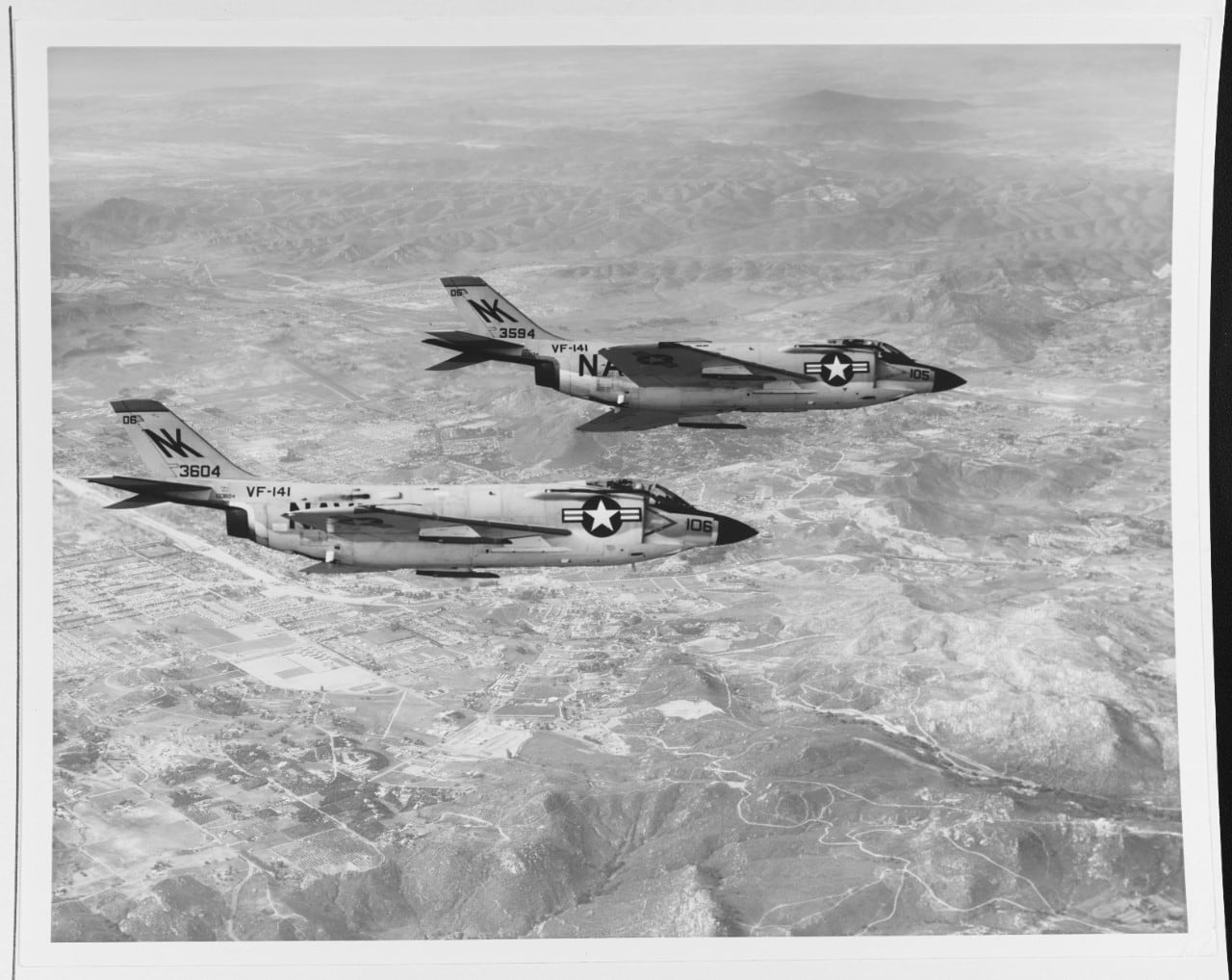
F3H Demon
The Demon was originally conceived in response to a mid-1948 Navy requirement for a carrier-based day fighter that would be comparable in all respects to contemporary land-based fighters (specifically the Air Force’s North American F-86A, which by that time had been tested and ordered into production).
After beating out 11 competitors, McDonnell was issued a contract to build two XF3H-1 prototypes in September 1949. The F3H utilized a conventional planform with wing and tail surfaces swept to 45 degrees, and like the Skyray was to be powered by a single Westinghouse J40 turbojet. While the prototypes were still under construction, the bureau added the requirement that production Demons be designed with all-weather capability as F3H-1Ns.
In what turned out to be a costly mistake, the F3H-1N was ordered into production even before the first XF3H-1 flew in August 1951. The J40-equipped F3H-1Ns were not only seriously under-powered, but the engine proved to be so unreliable that all 56 aircraft were ultimately grounded.
Rather then cancel the entire program, a decision was made in 1953 to substitute the Allison J71 engine (basically an upgraded J35).
The first J71-powered F3H-2N flew in April 1955, and deliveries to squadrons began in early 1956. The -2s appeared in three subvariants: F3H-2Ns, armed with four 20mm cannons and two infrared Sidewinders; F3H-3Ms, additionally armed with beam-riding Sparrows; and F3H-2s, optimized as strike fighters to carry up to 6,000 pounds of ordnance.
Total F3H production stopped in early 1960 after 519 had been built, and the last examples were withdrawn from operational service in September 1964.
The Demon, in its final variants, was basically a good weapons platform, but because of an overlong gestation period it was unavoidably overtaken by the F8U and F4H.
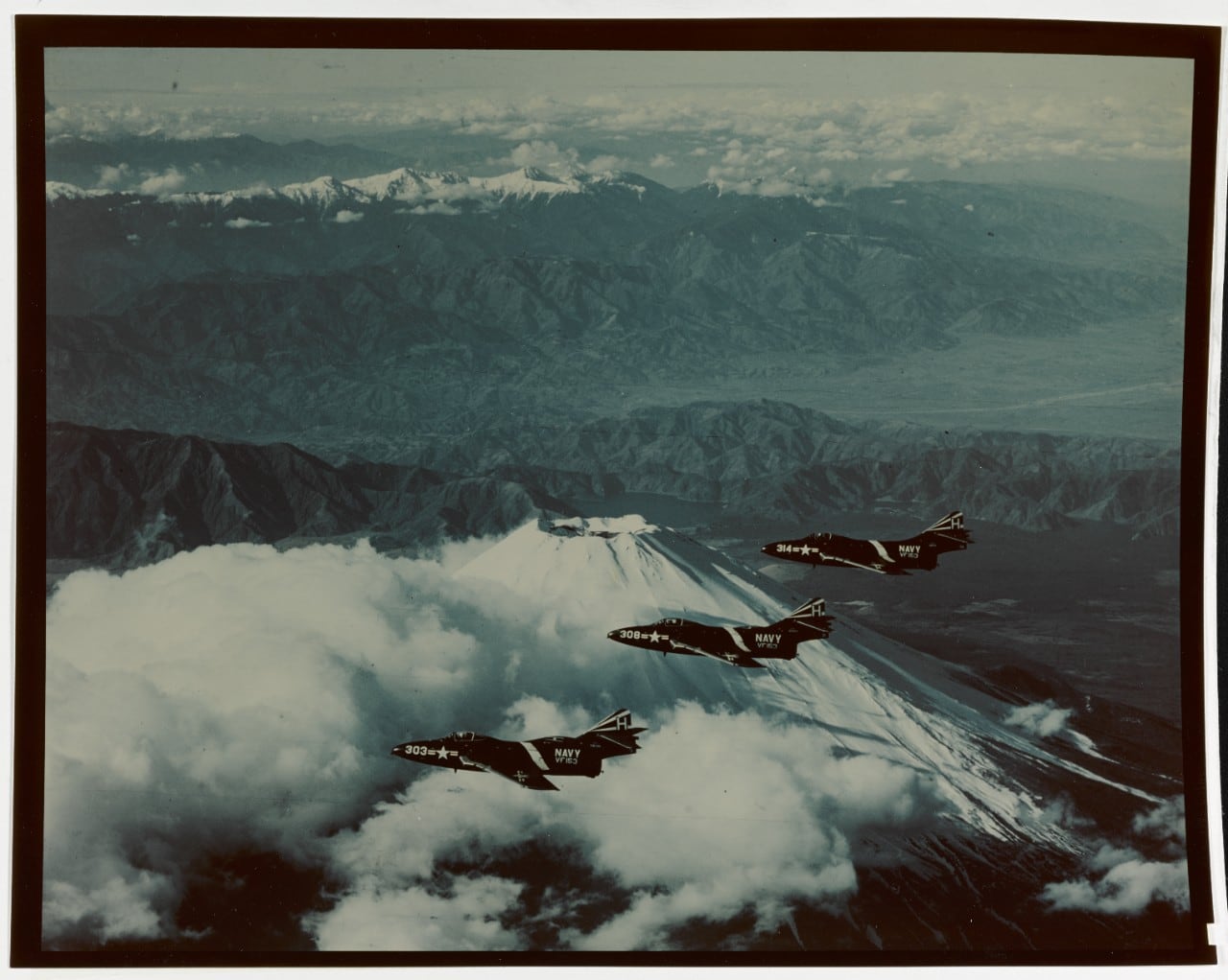
F9F Cougar
In late 1950, the appearance of the MiG-15 in Korea, combined with delays in existing Navy fighter programs, prompted bureau officials to press for development of a swept wing derivative of the Grumman Panther.
The XF9F-6 was essentially an F9F-5 fuselage adapted to a wing and horizontal tail both swept to 35 degrees. The fuselage was extended 2 feet in the middle to permit greater internal fuel (in lieu of tip tanks), and an uprated Pratt & Whitney J48 engine increased thrust by 1,000 pounds. Work proceeded rapidly, and the first Cougar prototype was flying by September 1951.
In testing, the XF9F-6 proved to be 100 mph faster than the Panther, and after initial stability problems were solved by the addition of an all-flying stabilizer and spoilers, the Cougar showed above-average carrier handling characteristics.
Cougars were ordered into production as the F9F-6 (J48) and F9F-7 (identical except for the Allison J33) and began reaching squadron service in November 1952. First flown in December 1953, the F9F-8 had a fuselage stretch of 8 inches for more fuel and a 15- square-foot addition to wings that produced a noticeable saw-tooth leading edge. F9F-8s were later retrofitted with nose-mounted refueling probes and were capable of carrying Sidewinder missiles.
The F9F-8B was fitted with a low altitude bombing system (LABS) so that it could operate in a strike fighter role. By the mid-1950s, the Cougar was the most numerous fighter in the naval inventory, but its service life was comparatively brief: It was phased out of frontline squadrons by 1959.
Cougars continued to serve in Navy and Marine reserve units until the mid-1960s.
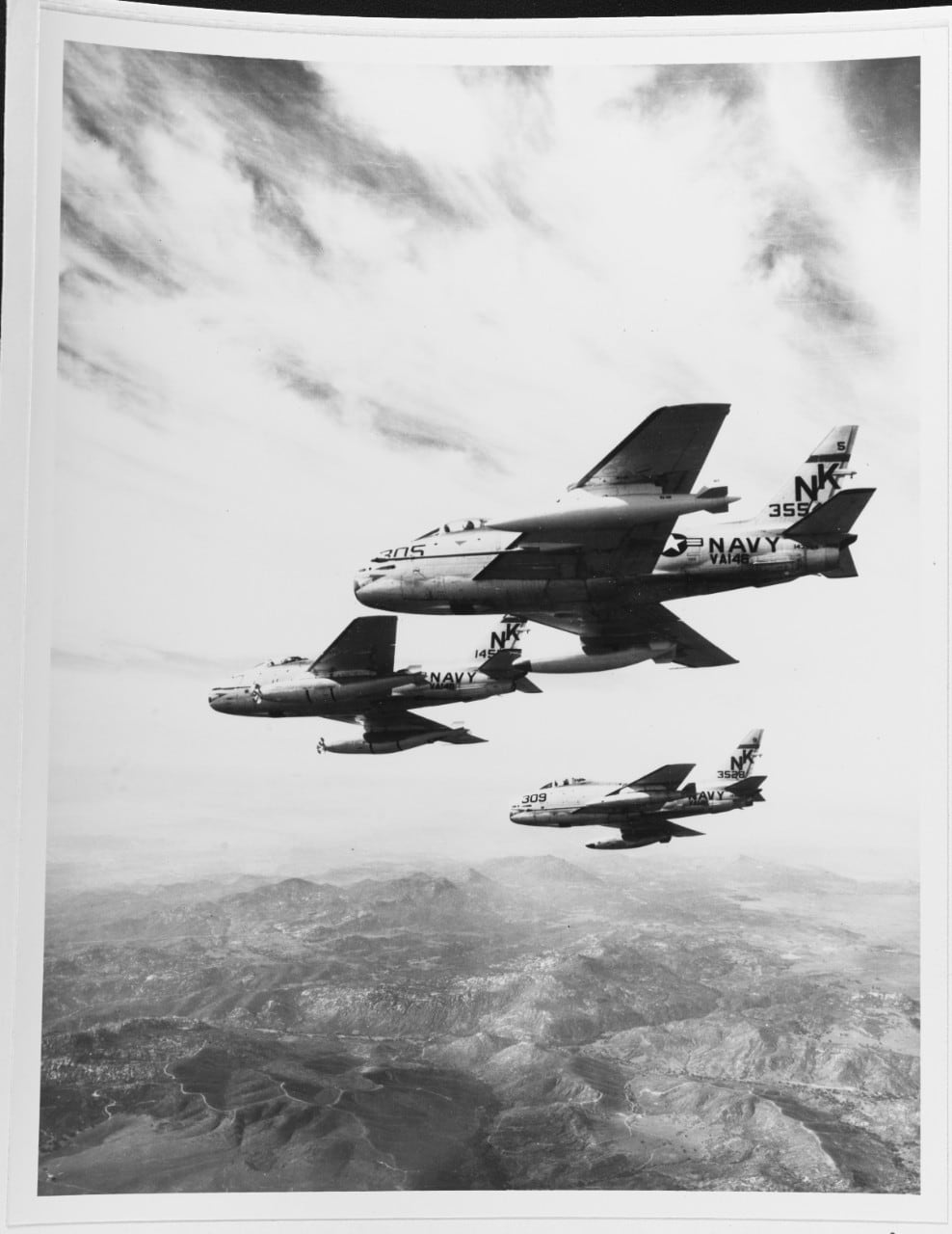
FJ Fury
In early 1951, the circumstances that gave rise to the Cougar also led bureau officials to seek development of a navalized version of North American’s excellent F-86 Sabre.
Right after the project was initiated, the Navy issued a contract for 300 airplanes as the FJ-2, and the first prototype, basically a J47-powered F-86E with catapult points and a V-frame arrestor hook, flew in December 1951. Production FJ-2s had other refinements such as folding wings, lengthened nose wheel strut, four 20mm cannons, no dihedral in the horizontal tail, a modified canopy and stronger landing gear.
When the Korean War ended, production was cut back to 200 planes. Unlike the competing F9F-6, FJ-2s revealed poor carrier handling traits and from 1954 to 1957 served only with six land-based Marine squadrons.
Work on the follow-on FJ-3 began in mid-1952, and the first example flew in July 1952. The -3 came with a more powerful Wright J65 engine, an enlarged nose intake and wing modifications that improved carrier handling qualities.
Delivery to fleet squadrons began in September 1954, and the type ultimately equipped 19 Navy and four Marine squadrons. The last batch of 80 aircraft was delivered as Sidewinder-carrying FJ-3Ms, with production ending in August 1956.
Like that of its Cougar stablemate, the service life of the FJ-3 was short, with all examples withdrawn from operational squadrons by 1960.
Though still in the Fury series, the FJ-4 of 1954 was essentially a completely new airframe. A new fuselage contour allowed 50 percent greater fuel capacity, and a new thin-section wing (similar to the F-100’s) incorporated leading edge droops coupled to the trailing edge flaps for slow speed control. Armament included four 20mm cannons and four Sidewinder missiles.
The prototype FJ-4 flew in October 1954, and production models began to reach operational units in 1955, ultimately equipping one Navy and three Marine fighter squadrons.
The FJ-4B was a dedicated ground attack version, flying for the first time in December 1956.
In addition to a stiffened wing and a low-altitude bombing system for tactical nuclear weapons, the -4B could also carry up to five Bullpup air-to-ground missiles and had air-to-air refueling capability.
After FJ-4Bs were issued to nine Navy and three Marine attack squadrons, production ceased in May 1958. The phase-out of FJ-4s and -4Bs began in 1959, and all had been withdrawn by the end of 1962.
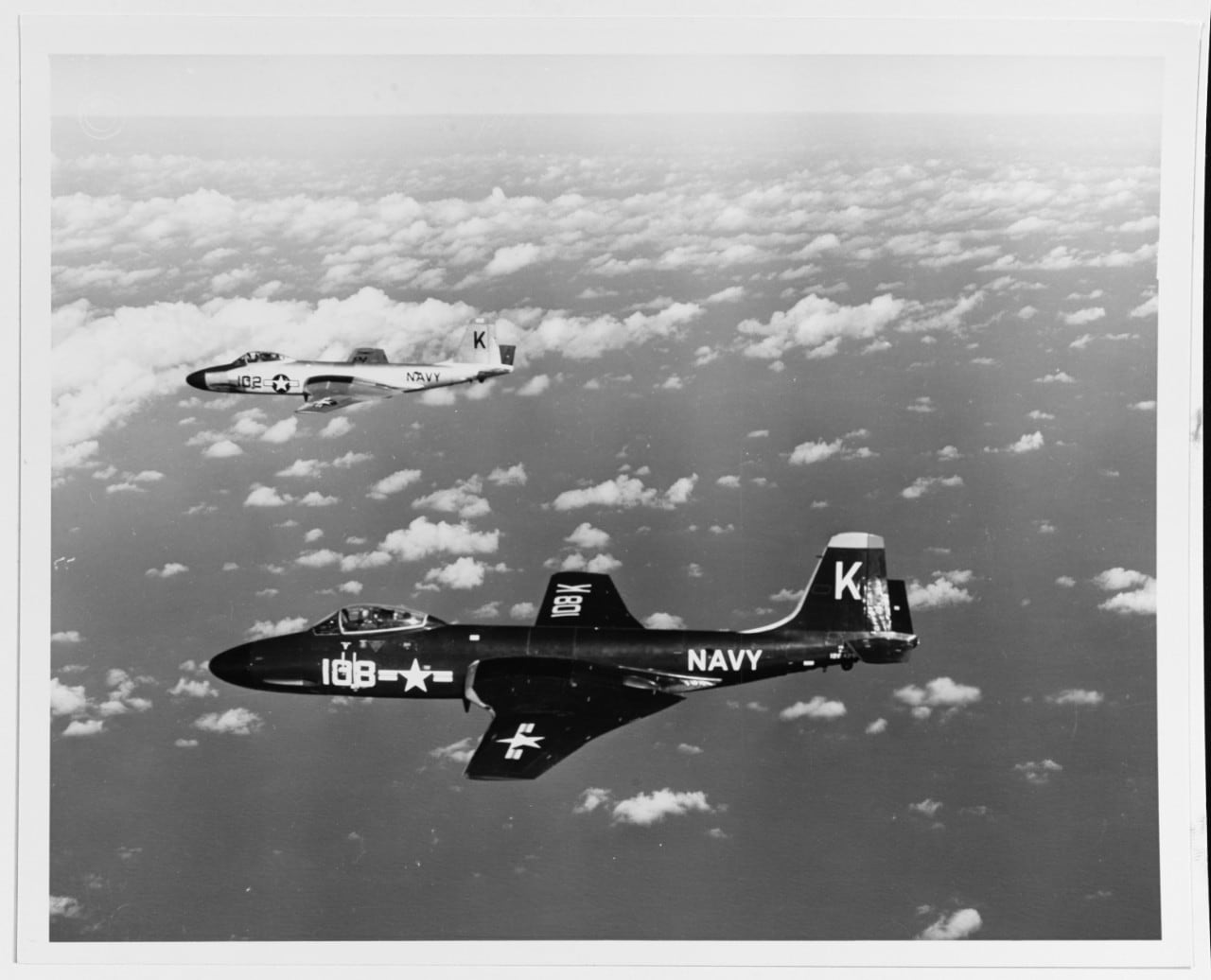
F2H-3 Banshee
The unexpected setbacks in the F7U, F4D and F3H programs in 1950-51 induced bureau officials to ask McDonnell to develop an all-weather version of its twin-engine, straight-wing Banshee. The F2H-3, introducing a longer fuselage, more wing area, redesigned tail surfaces and an APQ-41 radar system, flew in early 1952 and entered service later that same year.
The F2H-3 was followed in 1953 by the F2H-4, which had a better radar system and slightly uprated J34 engines. Both types equipped 12 Navy and two Marine squadrons, forming the fleet’s all-weather fighter capability until replaced by Skyrays and Demons during the mid- to late 1950s.
The last examples were withdrawn from frontline service in 1959, and a small number served with Navy and Marine reserve squadrons until 1961.
F10F Jaguar
The variable-sweep Grumman Jaguar represented an interesting attempt to develop a fighter with good handling characteristics in either high or low airspeed ranges. Based on experimental data amassed in the 1940s, Grumman conceived a jet fighter design with wings that could move fore and aft from 13.5 to 42.5 degrees.
Like the contemporary Skyray and Demon, Grumman’s project was planned around a single J40 engine. The Navy, encouraged by the design work, placed an initial order for a prototype and 30 pre-production models. When it made its first flight in May 1952, however, the XF10F-1 had materialized as a large (33,000 pounds loaded), highly complex aircraft with poor flying characteristics.
The Navy canceled its order, but the prototype was flown for several years at Edwards Air Force Base to evaluate the properties of variable-geometry flight.
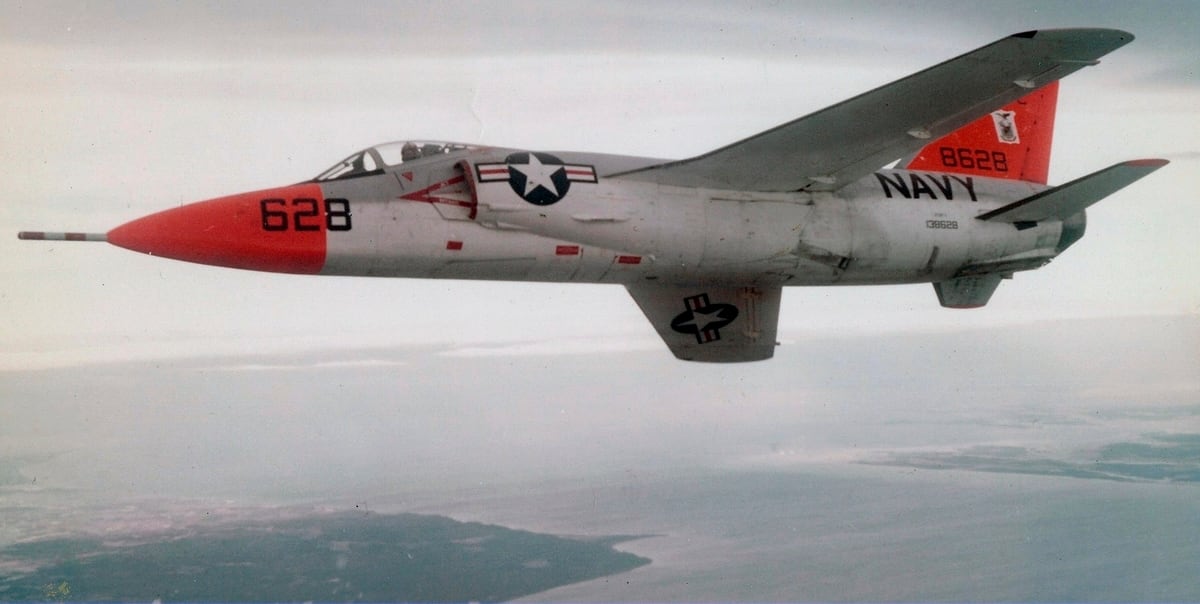
F11F Tiger
The Tiger began in 1952 as a company-funded effort by Grumman to explore the possibilities of applying area rule and a thinner wing section in order to obtain supersonic performance from the Cougar.
Though designated the XF9F-9, the design that evolved in the spring of 1953 bore no resemblance to the previous F9F series: a slim fuselage designed in accordance with area rule, with lateral intakes moved well forward; narrow-chord, shoulder-mounted wings that featured full-span slats and flaps and spoilers for roll control; main landing gear that retracted flush into the fuselage; and a low-mounted, all-flying stabilizer. Power came from an afterburning Wright J65 engine.
Armament consisted of four 20mm cannons and four Sidewinder infrared missiles. The first prototype flew in July 1954 before an afterburning engine was available but nevertheless achieved Mach 0.9 on the first flight. Once they were fitted with afterburners, prototypes easily exceeded Mach 1 in level flight.
The Navy ordered the Tiger into production under the new designation F11F-1, but protracted carrier evaluations and resulting modifications delayed their entry into service until early 1957.
Production ceased in January 1959 with the delivery of the 199th aircraft. F11F-1s equipped seven Navy fighter squadrons until 1961, when they were withdrawn from frontline service and used as jet transition trainers until mid-1967.
Despite their brief service, however, from 1957 to 1969 Navy Tigers became familiar to thousands of spectators when they were used by the Blue Angels flight demonstration team.
In an effort to get more life out of the design, Grumman initiated a project in 1955 to equip the Tiger with the General Electric J79. The resulting F11F-1F, or Super Tiger, flew in May 1956, and during testing in 1957 achieved a maximum speed of Mach 2.04 (1,320 mph) and climbed to an altitude of 80,250 feet.
By that time, however, the F8U was already entering service and the multirole F4H was in advanced stages of design. As a result, the smaller, mission-limited F11F-1F was not ordered.
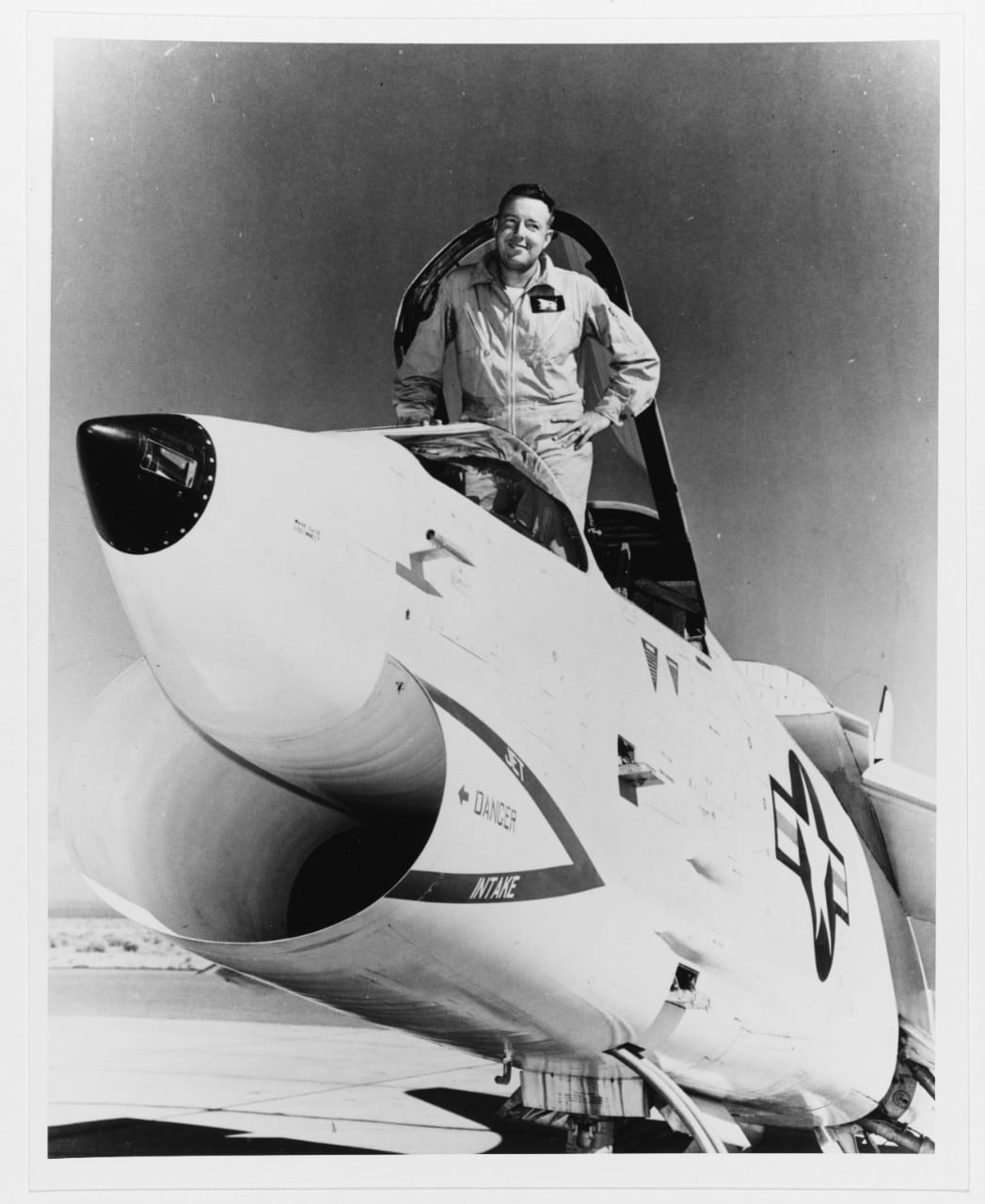
F8U Crusader
In the fall of 1952, the Bureau of Aeronautics circulated a new requirement for an air superiority fighter that could climb to 25,000 feet in one minute and accelerate to an intercept speed of Mach 1.2. In May 1953, after considering 21 proposals from eight different manufacturers, the bureau selected Vought’s entry, designated the XF8U-1, as the winner.
Designed around the Pratt & Whitney J57 engine (14,500 pounds static thrust in afterburner), the XF8U-1’s most outstanding feature was a variable-incidence wing in which the entire center section could be raised in flight to increase angle of incidence by 7 percent during takeoffs and landings.
In addition, while in the raised position, wing camber was increased by full span leading edge droops and ailerons that automatically lowered to 25 degrees. It had a long area-rule fuselage, and the cockpit was placed well forward behind a nose that housed a fire-control radar and incorporated a chin-type air intake below the radome.
Armament consisted of four 20mm cannons, two Sidewinder missiles and 32 2.75-inch unguided rockets in a retractable pack. The Navy ordered three prototypes in mid- 1953, and the first XF8U-1 flew in March 1955. Testing revealed the need for very few changes.
Production F8U-1s began reaching operational units in March 1957 and equipped nine Navy and Marine fighter squadrons by the end of the year.
Between 1957 and 1962, Crusaders were produced in four more versions: The F8U-1E had an improved fire-control radar; the F8U-2 featured an uprated J57 engine, ventral strakes on the tail to enhance high speed stability and the ability to carry two additional Sidewinders; the F8U-2N included improved radar and avionics for better all-weather capability and an approach power compensator (a computer stabilization system that controlled airspeeds during carrier approaches); and the F8U-2NE, the first version with substantial air-to-ground capability, introduced an all-new search and fire-control radar and infrared scanner, an avionics package for Bullpup air-to-ground missiles contained in a hump on the wing center section, plus provision to carry eight Zuni unguided air-to-ground missiles and 4,000 pounds of bombs on external racks.
In mid-1962, under a new designation system, the F8U became the F-8 (the F8U-1 became the F-8A; the F8U-1E became the F-8B; the F8U-2 became the F-8C; the F8U-2N became the F-8D; and the F8U-2NE became the F-8E). To extend the Crusader’s service life, 89 F-8Ds were remanufactured as the F-8H, 136 F-8Es as the F-8J, 87 F-8Cs as the F-8K, and 61 F-8Bs as the F-8L. F-8s served with distinction throughout the Vietnam War, and the last example was withdrawn from active service in 1976.
In 1956, although Crusader production was already underway, Vought began planning a Mach 2 successor to be powered by the Pratt & Whitney J75 engine. The resulting XF8U-3, although it bore a superficial resemblance to the F8U-1, was in effect a complete redesign. The first prototype, flying in mid-1958, was followed by two more prototypes. However, despite impressive performance (Mach 2.21, combat ceiling of 60,000 feet), the XF8U-3 was canceled in late-1958 in favor of the two-place F4H-1.

F5D Skylancer
The XF5D-1 started life as the XF4D-2N in 1953; the only characteristics it actually shared with the Skyray were its tailless planform and J57 power plant.
The XF5D’s 8-foot-longer fuselage was designed in accordance with area rule, and the wing section was considerably thinner. When the first Skylancer prototype flew in April 1956, it logged a 35 percent increase in performance over the F4D-1, but offered no important advantage over the F8U-1, which by that time was in full production.
Two prototypes and two service-test F5Ds were ultimately built and used in various military test programs during the 1960s, one serving with NASA until 1970.
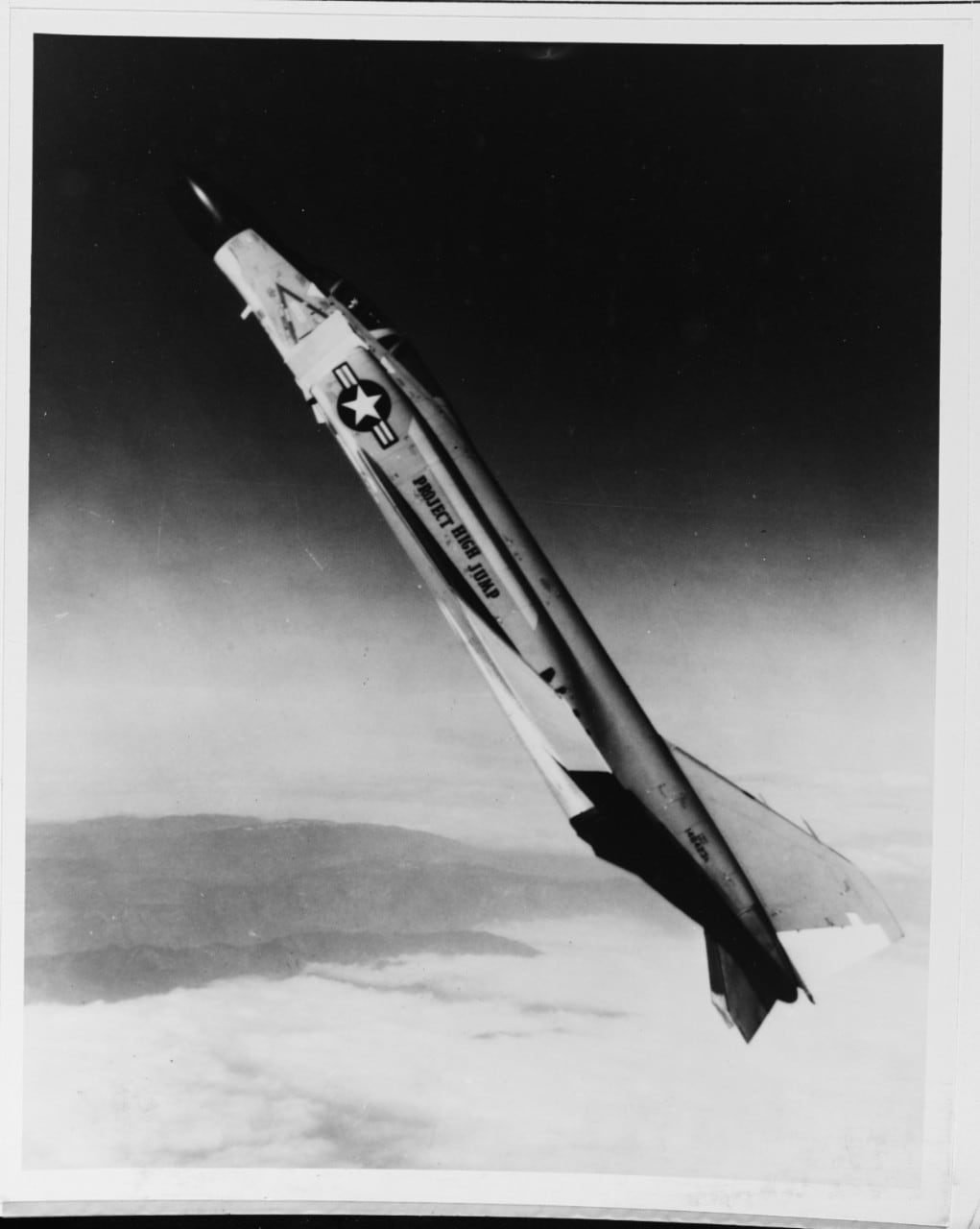
F4H Phantom II
In late 1953, after McDonnell’s proposal for a twin-J65-powered F3H lost out to Vought’s XF8U-1, the Navy encouraged the company to rework the design into an all-weather attack aircraft, the XAH-1. But soon after McDonnell submitted its attack proposal in mid-1954, the Navy revised its requirements again, this time for a two-seat, all-weather interceptor armed only with missiles.
Authorized as the YF4H-1, the mock-up was completed in November 1955, and shortly thereafter a decision was made to drop the J65s in favor of bigger General Electric J79s, which had the power to give the plane Mach 2 performance.
However, wind tunnel testing subsequently indicated that the YF4H’s planned aerodynamic configuration would be unstable at high speeds and therefore Mach limited.
To correct the problem, the horizontal stabilizer was given 23 degrees anhedral and the outer wing panels 12 degrees dihedral plus saw-tooth leading edges, which produced a look that would characterize the design. The YF4H featured other innovations such as “blown” flaps and slats, which used engine bleed air to keep the airflow attached to the wing at high angles of attack, and combination “flaperons”/spoilers for roll control.
The first YF4H-1 flew in May 1958, and initial flight trials were completed by the end of the year, after which the YF4H (later named Phantom II) was declared winner of the Mach 2 fighter competition and ordered into full production. Forty-five development aircraft were built as the F4H-1F, and subsequent production aircraft were manufactured as the F4H-1.
With the 19th development aircraft, the cockpit was elevated and the canopy enlarged, and a bigger, more bulbous radome was added to the nose. Carrier suitability tests commenced in early 1960, and the type began reaching transitional training units in early 1961, followed by deliveries to operational squadrons in mid-1961. In 1962 the F4H-1F became the F-4A and the F4H-1 became the F-4B.
By 1966, 29 Navy and Marine squadrons were flying F-4Bs. That same year, the F-4B was succeeded in production by the F-4J, which featured improved avionics and radar, more powerful engines and larger wheels to permit an increase in landing weight.
Navy and Marine Phantoms were introduced to combat in 1965 over Vietnam and served widely in both air-to-air and air-to-ground operations until American participation in the conflict ended in 1972.
In the early 1970s, 228 F-4Bs were upgraded as F-4Ns, which entailed a number of electronic enhancements and structural strengthening to extend service life; and in an analogous program instituted during the mid-1970s, 264 F-4Js became F-4Ss with new avionics and major structural improvements. The last F-4Ns and F-4Ss were retired from active Navy service during 1985-86, and from the last Marine squadron in 1992.
RELATED
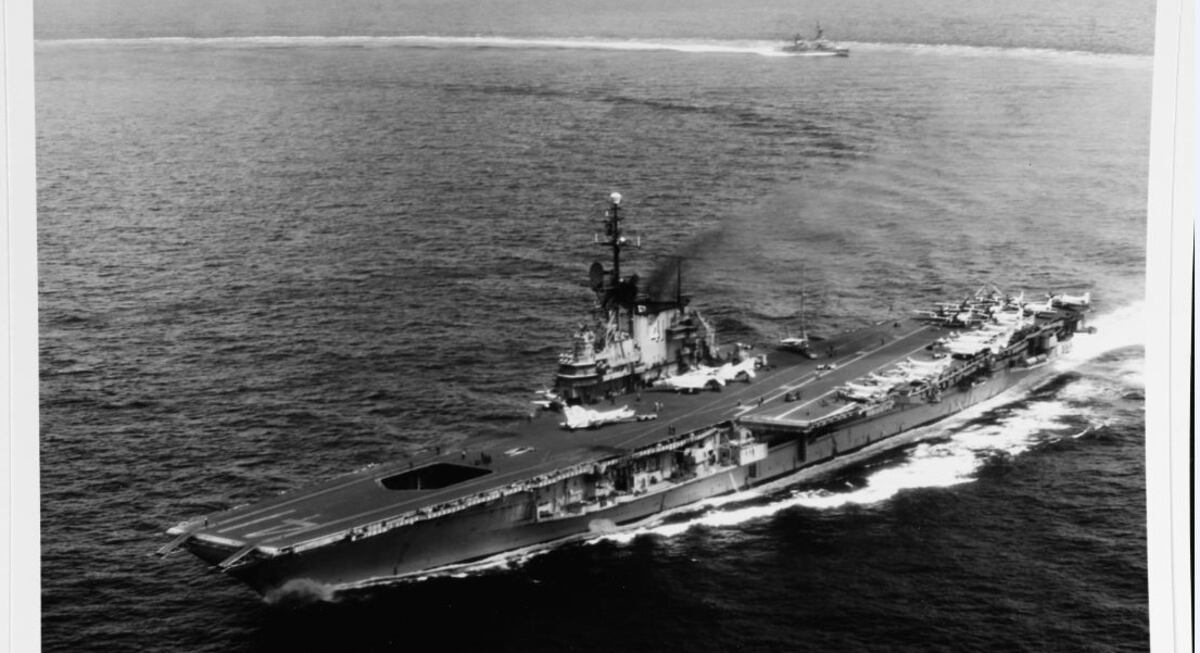
Persistence Pays Off
The sheer determination of the Naval Bureau of Aeronautics and American aircraft manufacturers during the 1950s finally paid off. By 1960, their efforts had not only closed the air superiority gap with the U.S. Air Force, but in the F8U and F4H had produced arguably two of the best all-around fighters in the world.
This was verified in the early 1960s when, confronted with the likelihood of conducting conventional (nonnuclear) air combat operations in remote areas of the world like Southeast Asia, naval aviation was better prepared than the Air Force, which had, during the same time frame, accumulated more than 5,000 fast but generally mission-limited Century Series fighters.
The final confirmation came in early 1962: The Department of Defense informed the Air Force top brass that their next-generation fighter would be a Navy design—the McDonnell F4H-1.
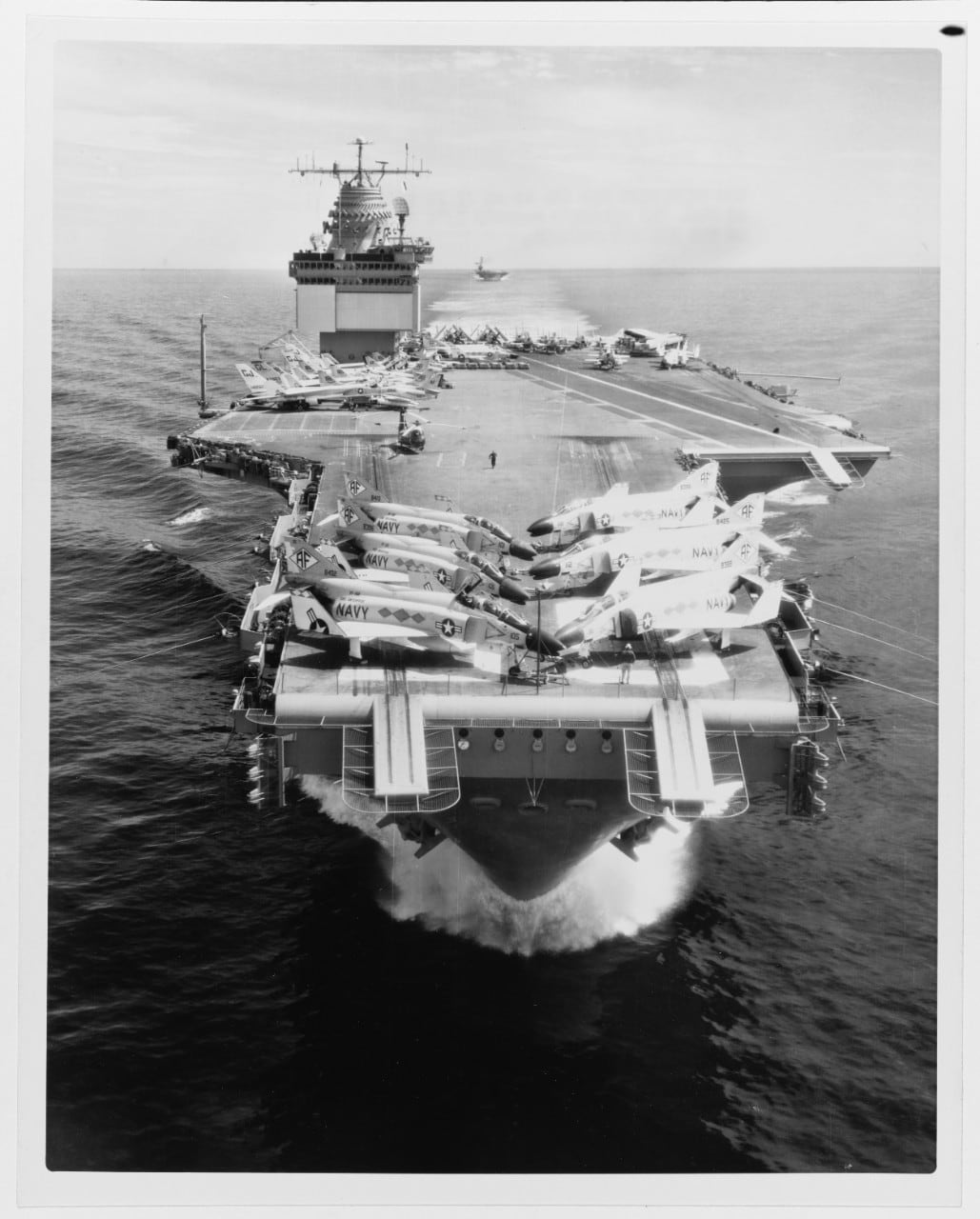
E.R. Johnson is a U.S. Navy veteran, a past president of the Arkansas Aviation Historical Society and a major in the Arkansas Wing of the Civil Air Patrol. For further reading, he recommends: United States Navy Aircraft Since 1911, by Gordon Swanborough and Peter M. Bowers, and The History of U.S. Naval Air Power, edited by Robert L. Lawson. This article was published originally in the January 2008 issue of Aviation History, a sister publication of Navy Times. To subscribe, click here.
